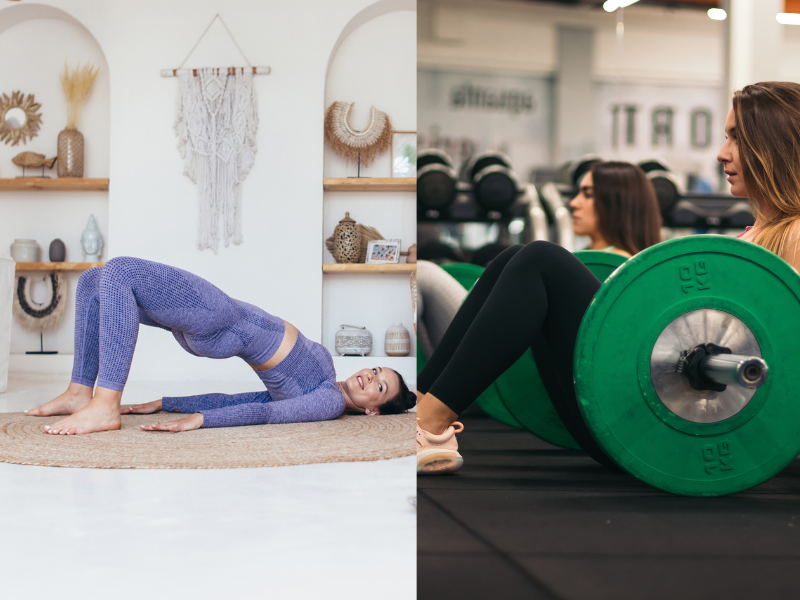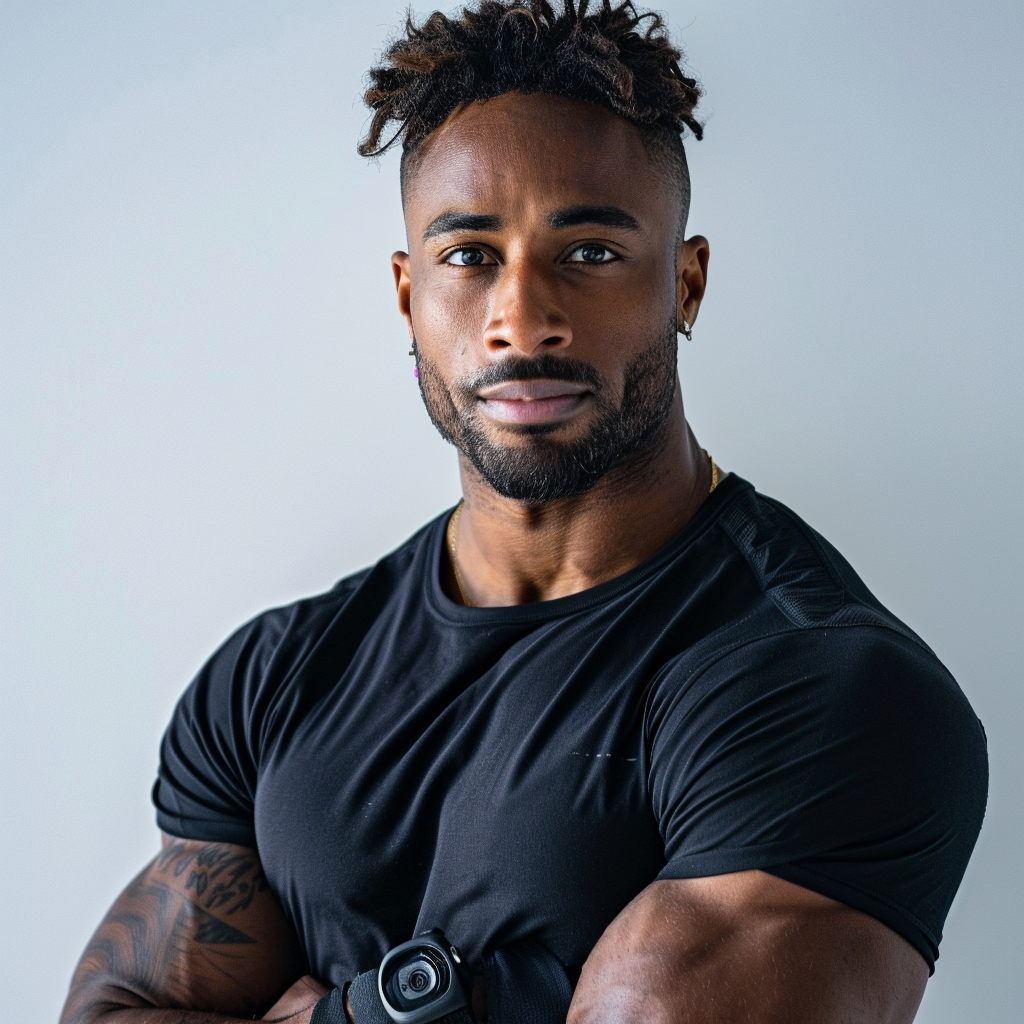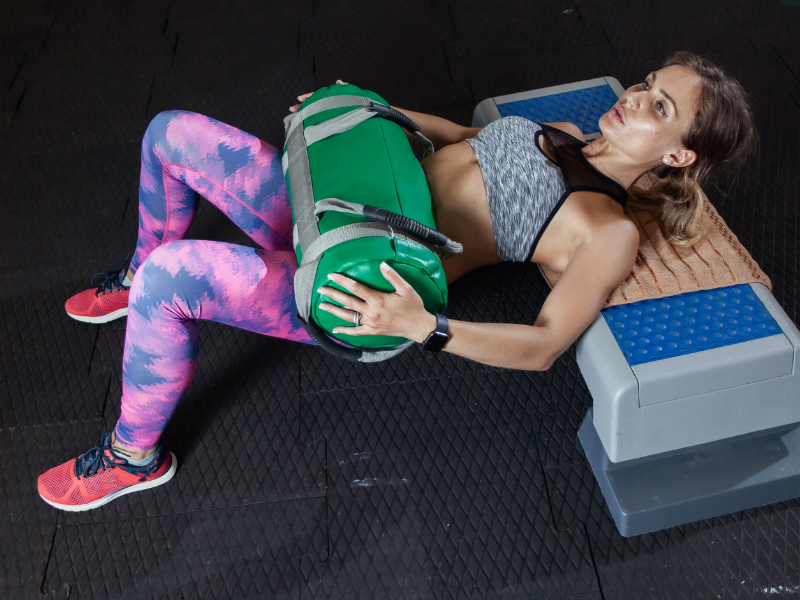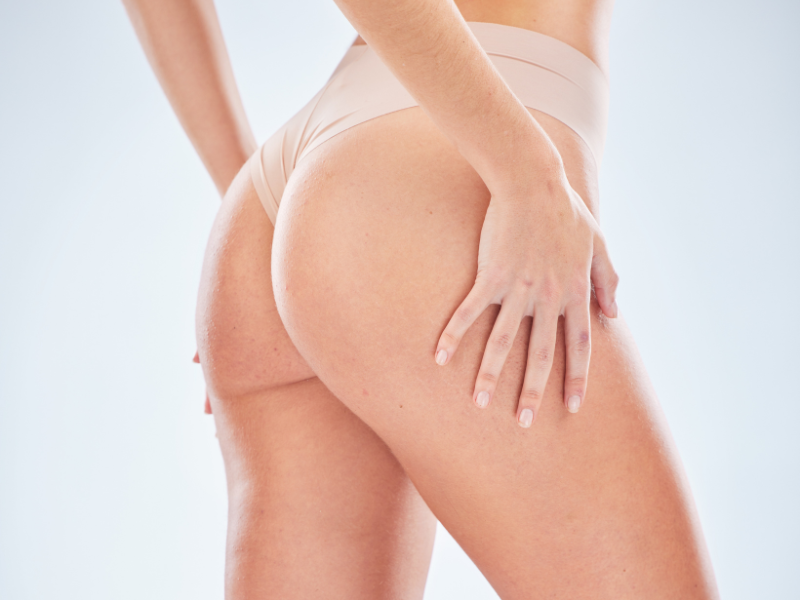




If you’re looking for exercises to boost your lower body strength, you’ve come to the right place. The B Stance Hip Thrust and Glute Bridge are two powerful glute workouts that also engage the hamstrings and core.
The B Stance variation provides a unique twist that emphasizes unilateral strength, helping to correct muscle imbalances and improve overall performance [1]. This guide will walk you through the proper techniques, benefits, and tips to maximize your workouts.
What is a B Stance?
A B Stance is a posture in which one leg bears most of one’s body weight while the other “non-working leg” is just there for support. In this stance, one foot is used for balance while the other foot performs the thrusting movement, allowing for better stabilization compared to single-leg hip thrusts. Of course, you need to switch the working leg between groups so that both sides can be worked, and these exercises can help with visible, growing glutes. The following video can act as a guide to help you understand better:
Glute Bridge vs Hip Thrust: What are the main differences?
Both glute bridges and hip thrusts target your glutes, hip flexors, abs as well as lower back muscles, but the two main differences between the variations are:

Glute bridges are usually done with your shoulders on the floor, while hip thrusts, also known as staggered stance hip thrust, are done with your shoulders against a bench or someplace a bit higher. Elevating the shoulders increases the range of motion.
Glute bridges have lower requirements for back strength and training intensity while hip thrusts need one to have a stronger core with higher training intensity and are often loaded with some weights.
Essentially, one can view the glute bridge as a more beginner-friendly bodyweight exercise for activation of the glutes, hamstrings, and the abs while the hip thrust can be perceived as an advanced exercise for enhancing glute muscle strength.

Other Glute Workouts You Can Try:
Reverse Hack Squat: How To Do It, Benefits and Alternatives
Banded Fire Hydrant: Exercise Guide
How to do: B Stance Hip Thrust & Glute Bridge
B Stance Hip Thrust
- Sit before a bench with the lower edge of the shoulder blade against the bench, knees bent and glutes resting on the floor.
- Place your left foot slightly behind the right and off to the side. Plant the heel of your right foot against the ground and bend your left leg to support the ground.
- With your chin slightly tucked in, engage your core, and push your hips up hard until your body is in a straight line from the knees to the shoulders.
- Clench your hips for 10 seconds, then slowly lower them back down.
- Some advanced trainers often hold a barbell or dumbbell on the hips to increase intensity.
B Stance Glute Bridge
B Stance Glute Bridge
- Lay down on your back and bend your knees with your feet slightly farther apart than your shoulders. Place your arms by your sides.
- Place your left foot slightly behind the right and off to the side. Plant the heel of your right foot against the ground and bend your left leg to support the ground.
- Raise your hips until your body is in a straight line from the knees to the shoulders. The upper back supports the floor when the hips are lifted. Hold for roughly 10 seconds.
- Slowly lower the hips down to the floor with your abs and glutes tight as you do.
- This is one complete move. Repeat 12 – 15 times, then continue on the other leg with a 20-second break. It is recommended to do it a total of 60 times per day.
What Muscles Does B Stance Hip Thrust and Glute Bridge work?

- Gluteus maximus, gluteus medius, and gluteus minimus
- Hamstrings
- Abdominis
- Quads
- Core
- Hip flexors
Benefits of B Stance Hip Thrust and Glute Bridge
These variations of B stance have distinct benefits, as well as overall benefits together.
B Stance Hip Thrust:
A single leg hip thrust focuses on one side at a time more than the other which facilitates glute activation and development.
By engaging the core muscles to stabilize the pelvic region, you achieve greater stability and balance.
This unilateral exercise focusing on one leg each time reduces the stress on the lower back and the knees in comparison to bilateral exercises [2].
It can help with enhancing strength gains by allowing for a deeper range of motion in the hip extension and helping with hip mobility [3]. Additionally, the B-stance hip thrust allows individuals to manage heavier loads and lift more weight by decreasing stress on the working leg.
B Stance Glute Bridge:
This variation also helps in activating the glutes, but particularly the gluteus maximus.
Unilateral, glute exercises helps in stability and strengthening the core [4].
It is a great exercise to incorporate for rehabilitation as it is great for strengthening the glutes while keep strain away from the knees and lower back [5].
It requires little to no eqipment other than a yoga mat, so it is convenient and also accessible to anyone from a range of fitness levels.
Overall benefits of Both Exercises

Both these exercises help in correcting muscle imbalances between the left and right sides of the body.
Help activate and grow your glutes for a nice heart-shaped or round butt.
They isolate the glutes and engage the hamstrings without straining other muscle groups in the body.
Being consistent with these workouts can help in improving hip stability and mobility.
More Glute Workouts You Can Try:
Fire Hydrant Exercise: How To Perform and Variations
How To Do Kneeling Squat Effectively
Common Mistakes

- When your pelvic muscles lean too much towards one side you can suffer from an anterior pelvic tilt. This can happen from putting too much weight on your waist. Keep your core tight and your gluteus maximus engaged.
- Use the hips as the center of the lift, not the middle and lower back.
- Always work one leg. Unless you already have an imbalance in your legs or an injury, you should alternate your legs during the exercise.
Conclusion
We hope this article gave you some comprehensive insight on the b stance hip thrust and glute bridge exercise variations. For more such strengthening workouts that can be incorporated in your fitness routine, check out the JustFit app!
What does BB hip thrust work?
What is the difference between staggered stance and B stance?
What do B-stance hip thrusts do?
Brazil, A., Needham, L., Palmer, J. L., & Bezodis, I. N. (2021). A comprehensive biomechanical analysis of the barbell hip thrust. PloS one, 16(3), e0249307. Available at: https://doi.org/10.1371/journal.pone.0249307
Buckthorpe, M., Stride, M., & Villa, F. D. (2019). ASSESSING AND TREATING GLUTEUS MAXIMUS WEAKNESS - A CLINICAL COMMENTARY. International journal of sports physical therapy, 14(4), 655–669. Available at: https://www.ncbi.nlm.nih.gov/pmc/articles/PMC6670060/
Liao, K. F., Nassis, G. P., Bishop, C., Yang, W., Bian, C., & Li, Y. M. (2022). Effects of unilateral vs. bilateral resistance training interventions on measures of strength, jump, linear and change of direction speed: a systematic review and meta-analysis. Biology of sport, 39(3), 485–497. Available at: https://doi.org/10.5114/biolsport.2022.107024





